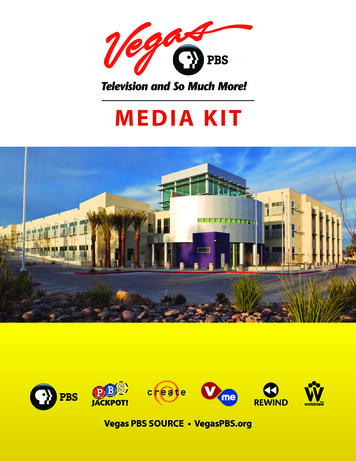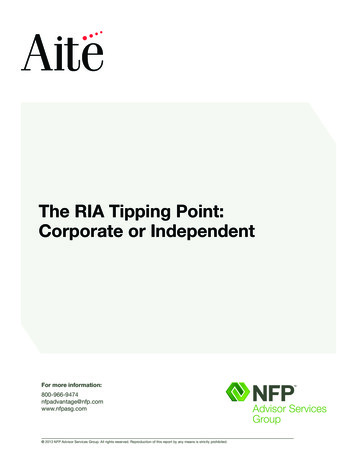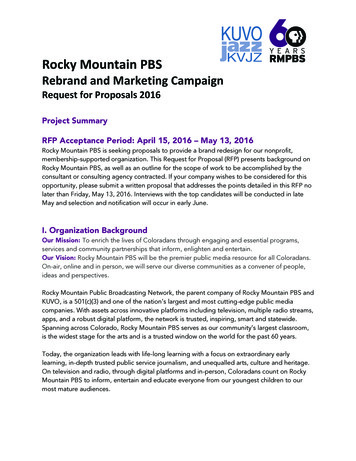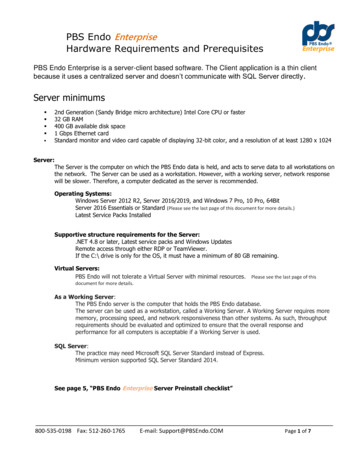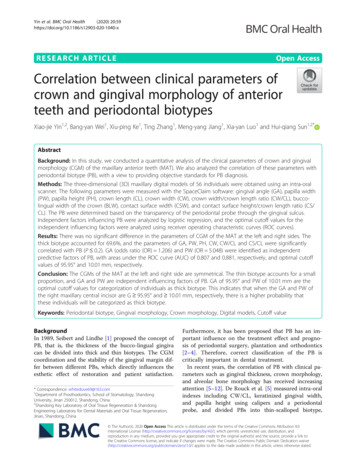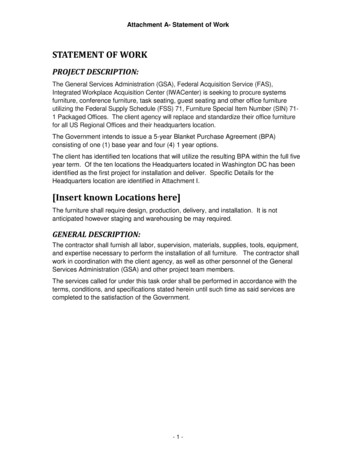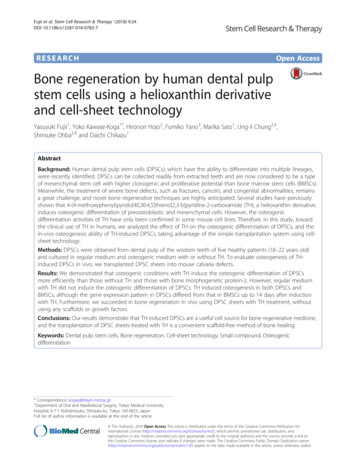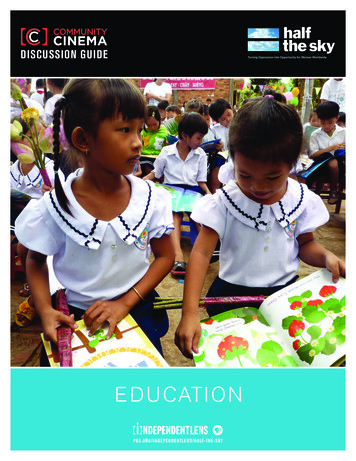
Transcription
DISCUSSION GUIDEe d u cati o nPbs.org/independentlens/half-the-sky
Table of Contents1Using This Guide2–34–65From the FilmmakerThe FilmThe Film: Episode OneThe Film: Episode Two67–88Background InformationThe Doi Moi and Room to ReadSon Selection and the Gender Imbalance89Education10Benefits of Educating Girls10Barriers to Education11What is Needed?12Education for All and the Millennium Development Goals13–14Thinking More DeeplyP HOTO CR E DITS: J O S H B E N N ETT, J E S S I CAC H E R MAYE F F, N I C K K R I STO F, J E N N I M O R E LLO,DAVI D S M O LE R15Suggestions for Action16Resources
Using This GuideCommunity Cinema is a rare public forum: a space for people to gather who are connectedby a love of stories, and a belief in their power to change the world. This discussion guideis designed as a tool to facilitate dialogue, and deepen understanding of the complexissues in Half the Sky: Turning Oppression into Opportunity for Women Worldwide. It isalso an invitation to not only sit back and enjoy the show – but to step up and take action.This guide is not meant to be a comprehensive primer on a given topic. Rather, it providesimportant context, and raises thought provoking questions to encourage viewers to thinkmore deeply. We provide suggestions for areas to explore in panel discussions, in theclassroom, in communities, and online. We also provide valuable resources, and connections to organizations on the ground that are fighting to make a difference.For information about the program, visit www.communitycinema.orgN OT E TO R E A D E R S :This discussion guide gives an overview ofthe entire two-hour Half the Sky: TurningOppression into Opportunity for WomenWorldwide film, and then provides specificbackground information and resourcesfor the country segment that deals withEducation in Vietnam.Discussion guide // EDUCATION1
“We wanted to create aunique experience that goesbeyond “issue” filmmaking tosimply tell incredible stories”From the FilmmakerMaro ChermayeffWorking in documentary film has always been an adventure, a pleasure,and a roller coaster ride — but rarely does a project come along thatchanges one’s entire worldview.Making Half the Sky: Turning Oppression into Opportunity for Women Worldwide hastruly been a life-changing endeavor and an honor. The concept for the transmedia projectwas originally brought to me by my fellow executive producers: Jamie Gordon and MikaelaBeardsley. Mikaela had recently produced the film Reporter about the intrepid New YorkTimes columnist Nicholas Kristof. She was very excited when, in conversations in thefield, he talked about his upcoming book to be co-written with his wife Sheryl WuDunnaddressing the struggles and triumphs of women and girls in the developing world thatthey had personally encountered over years of reporting.That book turned out to be the groundbreaking work, also titled Half the Sky: TurningOppression into Opportunity for Women Worldwide, which became an internationalbestseller. The game-changing element of the book is the focus on personal stories thatallow readers to deeply connect with individual, true stories of women and girls facinghorrendous difficulty and inequity. It tackles head on issues such as maternal mortality,sex trafficking, gender-based violence, and forced prostitution — and illustrates the hopeoffered by the life-changing opportunities of education and financial empowerment. Thestorytelling nature of the subject-driven narrative leant itself beautifully to documentary film.As a New Yorker, I knew of Nick’s work as a journalist for The New York Times, and of thehighly regarded Pulitzer Prize-winning articles that Nick and Sheryl had written togetherduring their tumultuous years as reporters based in China, but I had never met eitherof them. Nick and Sheryl believe in the power of social media and the potential of thissubject matter to reach new and diverse audiences through multi-platform content. Thisis where the larger concept of the transmedia project inspired by their book came from.Now, the project is launching on multiple platforms, with a four-hour television series forPBS and international distribution through Fremantle Media; a one hour film for CommunityCinema; free curricula developed for Community Classroom, over 20 short films andeducational modules made in partnership with some of the project’s more than 54 NGOpartners worldwide; mobile games for India and Africa (executive produced with Gamesfor Change with the support of USAID); a social-action Facebook game; and two websites —one housed on PBS.org and another advocacy-based site at halftheskymovement.org.Discussion guide // EDUCATION2
From the FilmmakerAs a filmmaker, the centerpiece ofthe project for me was the documentary series. Filmed in ten countries, theseries is inspired by Nick and Sheryl’swork — but also goes beyond the page tofilm new and immediate stories that lendthemselves to the drama that televisiondemands. Our approach was to orchestrate 2-week trips to six different countries,following Nick as he reported on an agentof change working to better her own lifeor the lives of women in her community.Joining Nick on each leg of the journeywas a different actress who had experience advocating for social issues, butwho was not an expert in the specificissue we were following in that location.Rather, she was there to act as the eyesand ears of the audience, allowing an intimate and honest way into some of thesetough and demanding stories. We had thegood fortune to be joined by Eva Mendesin Sierra Leone, Meg Ryan in Cambodia,Gabrielle Union in Vietnam, Diane Lane inSomaliland, America Ferrera in India, andOlivia Wilde in Kenya.The experience of the shooting was someof the most difficult I have ever experienced in over twenty years of producingand directing large and complicatedseries. Having directed a ten-hour seriesaboard the USS Nimitz on a six-monthdeployment to Iraq (PBS, Carrier), runDiscussion guide // EDUCATIONaway with a traveling circus (PBS, Circus),and made a film about toxic waste beingdumped on a Native American community(HBO, Mann v. Ford), I was prepared forand yet still stunned by the conditions inwhich most people in the world live. I wasespecially affected by the experiencesof women living under these conditions.From rough terrain to blistering poverty,the situations were incredibly challengingand the issues were often heartbreaking.For example, children being raped as earlyas two and three years old in post-conflictSierra Leone or the staggering reality oftrafficking and sexual slavery of younggirls in Cambodia. But the women weworked with were some of the most amazing, courageous, and admirable women Ihave ever known. The tears often flowed.Two of the more emotional experiencesoccurred while trying to help the fourteenyear-old Fulamatu seek justice againstthe uncle who raped her and two of herfriends, only to watch the case crumble,and during the harrowing brothel raid inCambodia with the fiery Somaly Mam thatfreed several under-age girls being heldin slave-like conditions where they wereforced to work as prostitutes with 10-30clients per day.Working with Nick and Sheryl was aninvaluable and amazing opportunity as adirector. I was so impressed by Nick inthe field as he tenaciously sought out thestory and by Sheryl’s incredible ability tosee the big picture and address the largeglobal issues. I knew I wanted to honortheir work. We all felt from the start thatit should be an epic production, visuallystunning and visceral, showing the amazing places we visited and people we metin all their beauty. We wanted the realityof their world to be accessible and yet,at times, shocking — an edge-of-your-seatadventure with global significance. Wewanted to tell true stories, yet also deepen people’s experience and understanding of the issues women and girls face inthe developing world. We also believed,and Nick and Sheryl were deeply committed to showing, that the stories couldand should be uplifting and empowering.Even in the darkest of circumstances, wefound the most startling humanity andconfirmation of the human spirit’s resilience. People who engage with all of ourcontent — on the multiple platforms available — will be angry, motivated, inspired,and most important, feel connected to thesubjects and themes. We wanted to create a unique experience that goes beyond“issue” filmmaking to simply tell incredible stories about the capacity of humanbeings to persevere against all odds andthe restorative power of opportunity inparts of the world that are not “over-there,”but a small leap from our own backyard.3
The FilmIn 2009, Pulitzer Prize winning-journalists Nicholas Kristof and Sheryl WuDunn published a ground-breakingbook about the oppression of women and girls worldwide. That book was Half the Sky: Turning Oppressioninto Opportunity for Women Worldwide — an instant bestseller that immediately catalyzed an alreadyburgeoning movement to eradicate gender inequality.The landmark PBS documentary series Half the Sky: TurningOppression into Opportunity for Women Worldwide aims toamplify the central message of the book — that women are not theproblem, but the solution — and to bolster the broad and growingmovement for change. Using the story of the book and its impactas a launchpad, the documentary zeroes in on the lives of girls insome of the countries around the world where gender inequalityis at its most extreme and explores the very real ways in whichtheir oppression can be turned to opportunity.Featuring six celebrated American actresses and the commentaryof the world’s leading advocates for gender equality, the film is apassionate call to arms — urging us not only to bear witness to theplight of the world’s women, but also to help to decisively transform their oppression into opportunity.Episode OneGender-Based ViolenceSierra Leone Eva MendesSex TraffickingCambodia Meg RyanEducationVietnam Gabrielle UnionEpisode TwoMaternal MortalitySomaliland Diane LaneIntergenerational ProstitutionIndia America FerreraEconomic EmpowermentKenya Olivia WildeHalf the Sky: Turning Oppression intoOpportunity for Women Worldwide is aspecial presentation of Independent Lensbroadcasting on PBS October 1st and2nd, 2012.Half the Sky: Turning Oppression into Opportunityfor Women Worldwide is a production of Showof Force and Fugitive Films in association withIndependent Television Service (ITVS). IndependentLens is jointly curated by ITVS and PBS and is funded by CPB with additional funding provided by PBSand the National Endowment for the Arts.Half the Sky: Turning Oppression into Opportunityfor Women Worldwide is inspired by Nick Kristofand Sheryl WuDunn’s book of the same name.Discussion guide // EDUCATION4
The FilmEpisode OneIn Episode One we follow Nicholas Kristof and three American actresses to developing countries wheregender discrimination is at its most extreme. We explore the shocking extent of gender-based violencein Sierra Leone with Eva Mendes, the global crisis of sex trafficking as experienced by women and girlsin Cambodia with Meg Ryan, and the need for and power of educating girls in Vietnam with GabrielleUnion, where she visits an innovative education program that is transforming, not only the lives of thecountry’s poorest and most vulnerable girls, but also the futures of their families and their communities.Featuring commentary from Sheryl WuDunn and interviews with some of the world’s leading advocates forgender equality — including Hillary Clinton, Michelle Bachelet, and Gloria Steinem — Half the Sky: TurningOppression to Opportunity for Women Worldwide offers a nuanced and moving account of this century’smost pressing problems, and an uplifting, actionable blueprint for change.Gender-Based ViolenceOur first stop is Sierra Leone, a countryrecovering from years of colonial oppression and a terrible civil war and which isstill suffering from rampant gender-basedviolence. Guided by Amie Kandeh, thepassionate and dedicated coordinatorof the International Rescue Committee’sWomen’s Protection and EmpowermentProgram in Sierra Leone, Kristof andactress Eva Mendes come face-to-facewith the enormous challenges women andgirls face in a country where rape is practically the norm — challenges embodiedby Fulamatu, a buoyant 14-year-old whohopes one day to become a bank manager. When we meet Fulamatu she wasraped repeatedly by a local church pastor — a family friend who is close enough tobe officially considered her uncle. She hadrisked the shame of telling her parentsand the ridicule of her community to breakher silence and press charges against theperpetrator. The outcome is a soberingobject lesson in the insidious effects ofgender-based violence, and the urgentneed to end impunity for the violators.Sex TraffickingAs interviews with WuDunn and some ofthe world’s leading advocates for genderequality explain, in many parts of the worldcultural attitudes and traditions are usedto justify the low status of girls, renderingthem vulnerable to all manner of exploitation and abuse. This is nowhere moreevident than in Cambodia, where thepernicious global problem of sex trafficking is perhaps at its worst. Actress MegRyan joins Kristof in Phnom Penh as hecatches up with Somaly Mam, one of thewomen profiled in the book Half the Sky:Turning Oppression into Opportunity forWomen Worldwide — a woman who washerself a child sex slave and who now hasdedicated her life to rescuing and rehabilitating others. As Mam’s story mergesand mingles with those of the girls in hercharge, the horrors of sex trafficking arewrit large — so too is the awesome resilience of the human spirit and the vast,untapped potential that resides in eachand every one of Mam’s girls.EducationThat potential, WuDunn and our luminaryadvocates tell us, is the key to betteringour world: tap into those girls and theywill change the future. The clarity of thatequation, the elegant cause-and-effect ofit, animates Episode One’s final sequence,in Vietnam, where former Microsoft executive John Wood’s organization Room toRead is transforming the lives of the country’s poorest and most vulnerable girls.Hosted by Bich Vu Thi, program officer ofRoom to Read’s Girl’s Education program,Kristof and actress Gabrielle Union getto know a few of the program’s stars andencounter firsthand the incredible obstacles which stand between these girlsand their bright futures. Still, these girlsare almost miraculously undaunted — andfiercely determined to change both theircircumstances and those of their families.The ripple effect of their education evennow is making itself felt — and there is nodoubt that with a little bit of help, a littleencouragement and support, these girlsand the tens of millions of others like themin the developing world will be a powerfularmy for change.Combining vivid, visceral on-the-groundstories with the commentary of a vast andimpressive roster of experts, advocates,and agents of change, Episode One takesus deep into the lives of girls in the developing world and makes us witness to theirseemingly impossible struggles — at oncechallenging and inspiring us to be a partof the vital, urgent project to empowerthem once and for all.Discussion guide // EDUCATION5
The FilmEpisode TwoEpisode Two continues our journey to the hot spots of gender oppression around the world and highlightsthe courageous work of some of the extraordinary women and men who are taking a stand in the faceof incredible odds. This episode focuses our attention on the role of women in their families and theircommunities — examining the fundamental obstacles that hinder their potential, and charting the ripple effectthat results when that potential is harnessed.Veteran journalist and Half the Sky: TurningOppression into Opportunity for WomenWorldwide co-author Nicholas Kristof isonce again accompanied by a three celebrated American actresses who offer freshand personal perspective on the issues ineach country. Kristof travels to Somalilandwith Diana Lane to examine maternalmortality and female genital mutilation,to India with America Ferrera to exploreintergenerational prostitution, and withOlivia Wilde to Kenya, where the transformative power of economic empowermentis changing women’s lives and is layingthe groundwork for the next generation. Inthe process, the film considers the centralrole of women in the health and stability oftheir families and communities and establishes their critical role in the global effortsto eradicate poverty and achieve peace.Featuring on-camera commentary fromSheryl WuDunn and some of the world’smost respected and outspoken advocatesfor gender equality — including MelanneVerveer, Zainab Salbi, and DesmondTutu Episode Two underscores the fundamental obstacles to women’s progressand prosperity and celebrates women’sboundless capacity to better our world.Maternal MortalityThe episode begins in Somaliland — anunrecognized country, populated mainlyby nomads, where the average womantoday has a 1-in-12 chance of dying inchildbirth. Joined by actress Diane Lane,Kristof reconnects with Edna Adan, founder of the Edna Adan Maternity Hospitalin Hargeisa. A spry 70-something womanoften and rightly described as a “force ofnature,” Adam is almost single-handedlyrevolutionizing the experience of childbirthin her country — providing medical care towomen who would otherwise have none,training midwives, and fighting tirelesslyDiscussion guide // EDUCATIONagainst female genital mutilation — a traditional practice still common in much ofAfrica (and elsewhere), which severelycompromises a woman’s ability to delivera child. In Somaliland, the challengeswomen face in the developing world arestarkly apparent: Poverty and traditionconspire to undermine a woman’s health,directly threatening her life, and having alasting impact on her children’s survivaland ability to thrive.Intergenerational ProstitutionAs WuDunn and our cast of gender equality advocates argues, tradition is, in manyways, the greater evil. In too many placesin the world, tradition still is used to marginalize women, to keep them down andin their place. This vicious cycle repeatsitself generation after generation, damaging and ending lives and undermining theability of thousands of women improvetheir quality of life and live their fullpotential. The key — as Kristof and actressAmerica Ferrera discover in India — isintervention by someone from the inside:someone like Urmi Basu. A social workerand an educated, middle-class Bengali,Basu has dedicated her life to stoppingthe cycle of intergenerational prostitutionin India, where 90 percent of girls bornto sex workers follow in their mothers’footsteps. What she is up against is neatlyillustrated by one of the young girls inher care, Monisha, who is on the brink ofbeing wrenched out of school and likelysold to a brothel by her own family — afamily that belongs to a sub-caste of sexworkers. What keeps Basu going is girlslike Sushmita — and more to the point,women like Sushmita’s mother, Shoma,who has lived the utter brutality and desolation of prostitution every day of her lifeand desperately wants a different fate forher daughter. Shoma’s hope for her childis the seed of real and lasting change.Economic EmpowermentWhen women have equal control overtheir finances and the financial decisionmaking on the personal, community,and national levels, everyone benefits.WuDunn and the many contributors wholent their voices and considerable expertise to Half the Sky: Turning Oppressioninto Opportunity for Women Worldwideall stress that putting money in the handsof a poor woman changes everything.During their visit to Kenya, Kristof andOlivia Wilde witness the impact of theeconomic empowerment of women firsthand. In this episode’s final segment,they explore the impact and challenges ofmicrofinance and the ways is transforming the lives of women and those aroundthem. We begin with Jane Ngoiri, a formersex worker-turned-dressmaker who is nowable to send her four children to school,where they are each at the top of theirclass, and end with Rebecca Lolosoli, aSamburu woman who built a safe havenfor women on the slender thread of a jewelry-making business. Kristof and Wildesee for themselves the dramatic andtangible transformation that can be set inmotion by a woman with a little money ofher own and a system of support to helpher make the best use of her financial andpersonal resources. Replicate the experiment several million times, and the worldwill be an entirely different place.The episode — and the film — ends withan urgent call to action, an invitation tothe viewer to take up the central moralchallenge of our time, and to join a movement that will tap the immense potentialof women to create a more peaceful andmore prosperous world for us all.6
BackgroundInformation“I told my children I don’t have land to givethem when they grow up. The only thing Ican give them is education.”– Hiep Dao Van, Father of Room to Readparticipant Phung Dao NgocIndividuals Featured inEducation in VietnamNicholas KristofJournalist; Co-Author of Half the Sky:Turning Oppression into Opportunity forWomen WorldwideIn Vietnam, girls are colloquially referred to as “flying ducks,” a sayingthat has its roots in Confucian tradition and refers to the belief thata girl’s value to her family is lost after her marriage. For parents whohave limited resources, choosing to invest in their sons’ education overtheir daughters’ seems like a better bet, since tradition dictates thatboys are responsible for taking care of their parents in their old age,while a girl’s skills and talents will benefit her husband’s family.Son preference is deeply rooted in many Asian countries, and daughters may be seen as aliability, especially where dowries must be paid. In the film, Bich Vu Thi, Room to Read Girls’Education program officer, talks about her own struggles achieving access to educationin a poor family where girls were not valued. She says, “One boy is one child, but tengirls are not equivalent to one child.” In a country like Vietnam where the average personearns just one dollar a day, the preference for boys coupled with other factors – such asthe need for daughters to help at home, the cost of schooling, and the long distancesstudents often have to travel to attend school — puts education out of reach for thousandsof girls whose families are living on the economic margins.Sheryl WuDunnJournalist; Co-Author of Half the Sky:Turning Oppression into Opportunity forWomen WorldwideJohn WoodFounder and board co-chair ofRoom to ReadGabrielle UnionActress; Ambassador for Susan G. Komenfor the Cure ; Founder of the “A Step forSuccess” programBich Vu ThiProgram officer of Room to Read’s Girls’Education programNhien LeKin AnCommunity organizer at Room to ReadDuyen LeThi NyStudent; Room to Read participantNhi Nu Thi HuynhStudent; Room to Read participantPhung Doo NgocStudent; Room to Read participantHiep Dao VanPhung’s fatherDiscussion guide // EDUCATION7
Background InformationThe Doi Moi and Room to ReadIn the 1980s, Vietnam’s government introduced a series of reforms aimed at improvingthe country’s living standards and economy. Since then, the Doi Moi (renovation), as it’scalled, has made great advances—specifically in the areas of growing private enterprise,attracting foreign investment, and transforming the country into an industrialized nation.But concerted efforts to improve education have been met with many challenges, especially in rural areas.Although Vietnam has made significant progress in achieving universal primary educationand improving girls’ access to schooling, the overall quality of education is poor by international standards and facilities and teachers are in short supply. Children in rural areasare forced to travel miles alone to reach the nearest school, and family responsibilitiesoften outweigh students’ hopes for education, with girls in particular dropping out so theycan contribute to the household income. Room to Read Vietnam was launched in 2001with the hope of reaching thousands of these children—especially girls—who would otherwise be denied an affordable, quality education.Sources:»» Liu, A. Y. C. 2001. Flying ducks? Girls’ schoolingin rural Vietnam. Asian Economic Journal 15 (4):385-403.»» www.roomtoread.org»» html»» id/301»» -quality-remain»» www.ibe.unesco.org/fileadmin/user upload/Publications/WDE/2010/pdf-versions/Viet Nam.pdf»» www.un.org.vn/en/publications/doc sheeton-education-in-viet-nam.htmlRoom to Read is an international organization that focuses on improving literacy andgender equality in education across the developing world. John Wood founded Room toRead in 1999 after a trek through Nepal, where he visited several local schools. Shockedby the lack of resources and moved by the dedication and passion of the students andteachers, John quit his senior executive position with Microsoft and began his journey tobuild a global team that would work with communities to create sustainable solutions totheir unique educational challenges.Room to Read now works with thousands of children in 10 countries throughout Asiaand Africa, and programs in countries such as Vietnam have had an indelible impact onstudents and their families. The organization’s work in Vietnam alone has included constructing 120 schools and establishing 567 libraries, and through its Girls’ Educationprogram it has been able to reach 1,972 girls who might otherwise have had little or noaccess to education.Son Selection and theGender ImbalanceAs a result of son preference, sex-selective abortions have become much more prevalentin Vietnam and the ratio of boys to girls has risen substantially to an average of 110 boysfor every 100 girls (and as high as 130 boys per 100 girls in some provinces). If thisgender imbalance continues to increase, there may be serious repercussions for womenand girls, who will face more pressure to marry at a younger age, making opportunitiesfor education and formal employment even less likely. There is also growing concern thatsuch an imbalanced ratio, coupled with lack of education and employment opportunitiesfor girls, could fuel the sex-work trade, as well as sex trafficking.Discussion guide // EDUCATION8
Education“When you educate a girl, there is a rippleeffect that goes beyond what you wouldget from a normal investment. Whenyou educate a girl, you educate a village.”– Sheryl WuDunn, Half the Sky: TurningOppression into Opportunity for WomenWorldwideSources»» www.unicef.org/education/index.php»» www.unicef.org/education/campaign.html»» www.ungei.org»» www.care.org/campaigns/education.asp»» www.unesco.org/education/efa/know sharing/flagship initiatives/girls.shtml»» poverty»» ION/0,,contentMDK:20298916 menuPK:617572 pagePK:148956 piPK:216618 theSitePK:282386,00.html»» www.girleffect.org/uploads/documents/2/GirlEffect Media Kit.pdf»» www.google.com/url?sa t&rct j&q &esrc s&source web&cd 3&ved 0CFQQFjAC&url http%3A%2F%2Fwww.unwomen.org.au%2Fliterature 48302%2FEducation for Womenand Girls caFactsheet&ei 4fjgT63rBajp0gGJxYSvDg&usg AFQjCNHHTXGSuDPelwlRXM65JAHkgSQ ZwAccess to education is recognized as a basic human right as well as a significant factorin breaking the cycle of poverty and improving quality of life for children, communities,and countries. Despite this, millions of girls and women around the world are disproportionately denied the opportunity to attend school and pursue education and trainingoutside the home.Of the approximately 75 million children who are currently not in school, the majority aregirls. Worldwide, for every 100 boys out of school, there are approximately 122 girls wholack access to education. In developing countries and countries with strict cultural andreligious codes regarding gender roles, this gap is much wider: For every 100 boys outof school in Yemen, there are 270 girls, in Iraq 316 girls, and in India 426 girls.Fast Facts Of the 781 million illiterate adults in the developing world, two-thirds are women, andnearly one out of every five girls who enrolls in primary school does not complete herprimary education. Nearly three-quarters of girls out of school are from excluded groups such as ethnicminorities, isolated clans, and very poor households, even though these groups representonly 20 percent of the world’s population. In the United States, the dropout rate for Latinas aged 16 to 24 is 30 percent, comparedwith 12.9 percent for blacks and 8.2 percent for whites, and only 10 percent of Hispanicwomen complete four or more years of college, compared with 13.9 percent of blacksand 22.3 percent of whites. U.S. women comprise 48 percent of the U.S. workforce but just 24 percent of science,technology, engineering, and math workers. Educated women have greater control over their financial resources and are more likelythan men to invest their resources in their families’ health, education, and nutrition. No country has ever achieved continuous and rapid economic growth without first havingat least 40 percent of its adults able to read and write. An extra year of primary schoolboosts girls’ eventual wages by 10 to 20 percent and an extra year of secondary schoolincreases earnings by 15 to 25 percent. Educating women increases productivity in agrarian communities. According to a 2005report by the United Nations (UN), if female farmers in Kenya were provided with thesame education and resources as male farmers, crop yields could rise by 22 percent. One year of female schooling reduces fertility by 10 pe
That book turned out to be the groundbreaking work, also titled Half the Sky:Turning Oppression into Opportunity for Women Worldwide, which became an international bestseller. The game-changing element of the book is the focus on personal stories that allow readers to deeply connect with individual, true stories of women and girls facing

